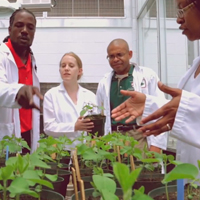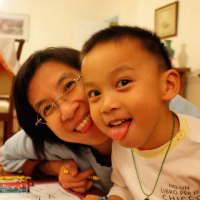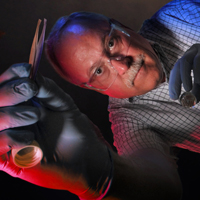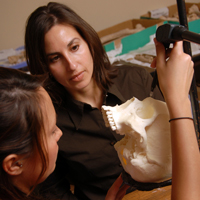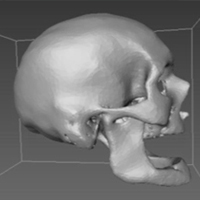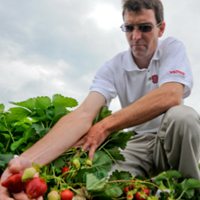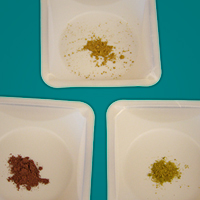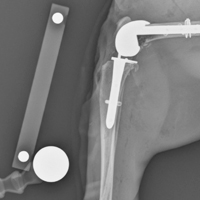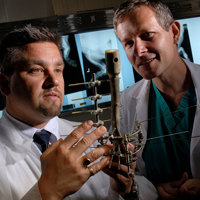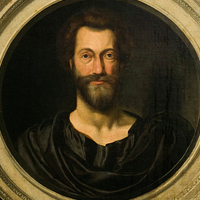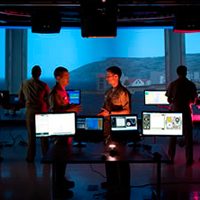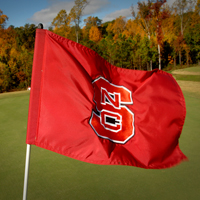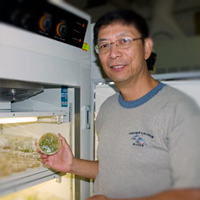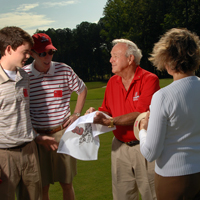Dr. Randy Woodson, NC State’s 14th chancellor, is well known for bridging vision and action.
From the Chancellor
It’s an exciting time to be in the innovation business — and to be at NC State.
It’s no wonder the university is known for its forward-looking philosophy: Think and Do. NC State is recruiting some of the brightest minds in the world to collaborate across disciplines to solve the grand challenges facing society.
Visit our campus and you’ll find faculty and students putting ideas into action in fields such as synthetic and systems biology, geospatial analytics and translational regenerative medicine.
Everywhere you go you’ll meet creative thinkers who are changing how we view the past, live in the present and plan for the future.
In an immersive visualization lab in the new James B. Hunt Jr. Library, you can have the experience of visiting 17th-century London and hearing a speech by Elizabethan poet John Donne, expertly re-created by a team of more than 50 researchers, artists and technicians.
In a nearby research building you can watch students and faculty use video game technology to make a 3-D version of a crime scene to help detectives crack a difficult case.
And you can visit an off-campus institute where university researchers are collaborating with industry scientists to unlock the health-promoting properties of chemicals found in ordinary plants that grow around the world.
Wherever you turn, you’ll find students engaging their hands as much as their heads, preparing for careers in more than 100 fields and doing what we do best at NC State: creating economic, societal and intellectual prosperity for all.
As you learn about some of the people, ideas and discoveries that make NC State such a vibrant university, I hope you’ll join me in embracing the spirit of innovation and purpose that drives our efforts and makes the future look brighter than ever.

Randy Woodson
Chancellor
Collectively, NC State faculty have earned more than 85 National Science Foundation CAREER and presidential awards in the past 10 years.
Talking ‘Bout My Generation
NC State’s extraordinary faculty stand at the forefront of interdisciplinary innovation, creating answers to some of society’s toughest challenges and preparing the next generation of leaders in industry, academia and public service.
Teams Unrivaled
NC State researchers are continually developing products and technologies that drive the economy and improve quality of life today.
NC State is also investing in the future by driving the most innovative emerging fields in higher education — disciplines such as big data, geospatial analytics and regenerative medicine.
The Chancellor’s Faculty Excellence Program is assembling hundreds of faculty members in interdisciplinary clusters to solve some of society’s most challenging problems.
These world-leading researchers are dedicated to decoding the complex interactions underlying the human genetic blueprint, creating new biological factories to meet the growing demand for sustainable food and energy, and harnessing new digital technologies to improve the way we teach and learn in the information age.
Jennifer Kuzma, professor of public and international affairs, is part of NC State’s Genetic Engineering and Society cluster studying the complex interplay of science and humanity. The job is tailor-made for her, mirroring her collaborative approach to academic work.
“We have ethicists, sociologists, historians, molecular biologists and entomologists working together,” she says. “Our research, education and engagement span disciplines and departments, helping to solve some of the practical problems confronting society.”
In a time of increasing globalization, this kind of real-world collaboration focused on purposeful outcomes is defining the future of higher education.
Students and faculty across campus work together in collaborative teams to explore new forms of business innovation and to bring new products and services to local and global marketplaces.
The Science of Crime Scenes
The bones from a body found in Texas are awaiting inspection in a lab at NC State.
Across campus, researchers are building a database to help crime scene investigators examine and compare fibers from automobile upholstery. In another building, researchers use video game technology to make a 3-D version of a crime scene appear on a screen. In a courtroom miles away, an entomologist prepares to testify in the case of a suspected serial killer.
It sounds like a television drama, but it’s just another day at NC State. All across the university, faculty from different disciplines have teamed up to develop a forensics institute that provides crucial help to law enforcement investigators.
The institute puts a wide range of expertise to use, from textile researchers studying fibers found at crime scenes to insect experts who can pinpoint a person’s time of death by examining larvae found in the decomposing body.
“The university is poised to become a national — even global — leader in this area,” says David Hinks, a professor of textile chemistry who is leading the NC State Forensic Sciences Institute.
NC State drives innovation in forensic science, bringing together interdisciplinary teams of faculty across the colleges, collaborators from law enforcement agencies and researchers from partnering universities and institutions.
NC State’s research inspires students, enhances teaching, spurs innovation and fuels the economy.
Born In A Crossfire Hurricane
NC State is an innovation powerhouse and one of the nation’s top research institutions.
Fueled by more than $400 million per year in externally sponsored research investment, our students and faculty turn ideas into solutions and chart new pathways for the future.
Big Ideas in Big Data
What if social networks were smart enough to “forget” old connections who were mere acquaintances? What if search engines could “forget” obscure images and random Web pages barely glanced at years ago? Imagine a future where information technologies possess human qualities — such as forgetfulness.
That future is possible, says Michael Rappa, director of NC State’s Institute for Advanced Analytics. In fact, forgetful technology may be necessary in our increasingly connected world.
“To help people negotiate the digital universe,” says Rappa, “we need to invent algorithms that usefully mimic how we function as human beings.”
The institute, a pioneer in the field of big data analytics, was established in 2007 to train top students from around the world who want to master the complex methods and tools used in large-scale data modeling.
The institute’s flagship program is the nation’s first Master of Science in Analytics degree, an intensive, full-time, 10-month course of study with an innovative curriculum. The institute draws from 10 of the university’s colleges — including programs of study in computer science, computer engineering, statistics and business — to provide a world-class cross-disciplinary education.
The Institute for Advanced Analytics produces more analytics graduates than any other U.S. analytics program and produces some of the university’s most sought-after and highly paid graduates, with a 92 percent job placement rate following graduation and starting salaries averaging $95,700.
The development of the institute was no accident. NC State has a long history of producing top mathematics and statistics graduates and of playing a central role in the development of future leaders in the critical advanced analytics field.
The goal of analytics is to derive and effectively communicate actionable insights from a vast quantity and variety of data.
Lost World Found
It was new. It was big.
And from the first time NC State paleontologist Lindsay Zanno saw the fossilized bone fragments on a dusty hillside in Utah she knew that she and her team had found something really important.
And it was: a 30-foot long, four-ton predatory dinosaur that helped fill in more than 60 million years in the fossil record.
Zanno, the director of the Paleontology and Geology Research Lab at the North Carolina Museum of Natural Sciences, spent five years excavating and studying the bone fragments from the Cedar Mountain Formation in eastern Utah.
In November 2013, she announced the discovery of Siats meekerorum, an enormous carnivore that lived 98 million years ago.
Zanno determined that the specimen found was a juvenile, so she estimates that Siats — so named in honor of an ancient Ute tribal legend — is one of the two or three biggest predators to ever roam North America, trailing only the legendary Tyrannosaurus rex, which was about twice Siats’ size.
What makes the discovery important is that Siats fills in a biodiversity gap between the Late Jurassic period and the Late Cretaceous period.
“There’s a huge gap in our understanding of what lived in between those two really unique dinosaur ecosystems,” Zanno says.
The discovery is the first of many Zanno hopes to announce in coming years from the dusty digging she and her team have done in the massive dinosaur grave site.
“In the next three to five years we really hope to be able to bring to light more of what this lost ecosystem looked like,” Zanno says.
Named after a cannibalistic man-eating monster from Ute tribal legend, Siats is a species of carcharodontosaur, a group of giant meat-eaters that includes some of the largest predatory dinosaurs ever discovered.
More about: Dinosaurs
-
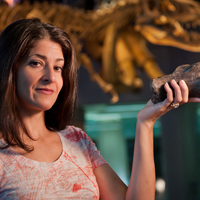
Get the inside scoop on Lindsay Zanno’s discovery of Siats meekerorum in the desert of eastern Utah.
-
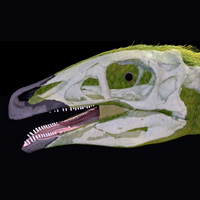
Scientists study differences between predator and prey by re-creating the brain of a 90-million-year-old dinosaur.
-
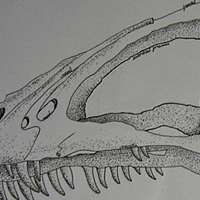
Researchers prove that ancient dinosaur skeletons contain original proteins preserved for 80 million years.
When NC State researchers step up to the drawing board to confront the grand challenges facing society, they work side by side with innovative partners in the business, government and nonprofit sectors.
Listen To The Color Of Your Dreams
NC State’s strong partnerships in both the public and private sectors foster a culture of collaboration that inspires faculty and students to pursue real-world solutions that span technologies, industries and disciplines.
Pathways to Health
Since it was founded in Kannapolis, N.C., five years ago, the Plants for Human Health Institute has worked to unlock the mysteries of phytochemicals, the bioactive agents that give plants their color, flavor, taste and smell.
Anthocyanins, for example, are the pigments responsible for the dark skin of the blueberry. Phenolic acids give vanilla and licorice their complex aromas and put the zing in chili peppers.
The center’s director, Mary Ann Lila, explains that plants are composed of “a complex cornucopia of chemicals” numbering in the thousands.
There’s mounting evidence that some phytochemicals have beneficial properties, including the ability to reduce inflammation, prevent obesity, relieve pain and lower the risk for diseases like cancer and stroke.
The field is wide open for research, and the Plants for Human Health Institute has quickly emerged as a global leader — literally.
Lila travels around the world, leading teams of graduate students and researchers on bioexplorations to discover and test the healing power of plants.
That work has taken her from Africa and Asia to South America, Australia and New Zealand.
Last summer, the institute launched a public-private partnership that gives undergraduates the opportunity to conduct hands-on research under the guidance of Ph.D. students, university faculty and industry research leaders.
Working in six labs, the students are tasked with mapping plant genomes and then charting specific chemical pathways that may lead to products with health-improving properties.
The project is an innovative collaboration that leverages the strengths of the research campus, home to some of North Carolina’s top universities as well as industry giants such as General Mills, Monsanto and Dole Nutrition Research.
Mary Ann Lila, center, leads teams of researchers and grad students on bioexplorations to uncover the disease-fighting properties of phytochemicals.
More about: Plants for Human Health Institute
Medicine’s Leading Edge
At NC State’s Veterinary Health Complex, faculty, staff and students are abuzz with talk of translational medicine: the practice of advancing human medicine through groundbreaking medical techniques and treatments initially developed for animals.
The future of medicine is very much in evidence in the $72 million facility, where a multidisciplinary team is creating the next generation of prosthetic limbs and joints.
A recent project — the world’s first fully functioning feline knee replacement — involved more than a dozen collaborators in both medicine and manufacturing on two continents. The result was a custom implant, fashioned out of cobalt chromium, that acts more like a natural limb.
“It was a state-of-the-art engineering project and a state-of-the-art surgical project,” says veterinary surgeon Denis Marcellin-Little.
The project tapped a 3-D printing process called rapid prototyping, which uses an electron beam to melt layer after layer of a metal alloy.
This allows fabricators to create intricate and complex structures, such as porous bone implants, from the strongest materials.
People with missing or deformed limbs may soon benefit from this cutting-edge work.
The pioneering feline Cyrano and a team of NC State surgeons and engineers are transforming the field of prosthetic implants for both animals and humans.
A virtual re-creation of a sermon given by John Donne at St. Paul’s Cathedral as it stood in 1622 has opened at NC State’s Hunt Library, in a state-of-the art teaching theater that offers 270-degree projections.
Have You Ever Been Experienced
As the leader in experiential education, NC State gives students rich opportunities to put learning into action.
From internships at some of the world’s top companies to service-learning trips to remote regions of the globe, students develop personal and career-ready skills.
Humanities Embrace Technology
At NC State’s new James B. Hunt Jr. Library, students immerse themselves in the advanced computer technologies that are driving the future of entertainment and education.
Students who work in the library’s game lab experience the ultimate in hands-on education: designing games on a 21-foot-wide ultra-HD display with four times the resolution of a standard HD monitor and a color gamut far exceeding broadcast television specifications.
“It’s the greatest experience I’ve had in college,” says graphic design senior Yusuf McCoy, who worked with a multidisciplinary team of design and computer science students to create a custom game to show off the system’s jaw-dropping capabilities.
But it’s not just students who are excited about the library’s technological prowess.
“The technology finally caught up with my ambition,” says English professor John Wall. For the past few years he’s been working with David Hill, assistant professor of architecture, and Hill’s graduate research assistant Joshua Stephens, on a project to create a digital simulation of Paul’s Cross courtyard in London’s St. Paul’s Cathedral, as it stood in 1622.
Drawing from historical images and a detailed survey of the original foundation prepared by the cathedral’s resident archaeologist, John Schofield, Wall’s digital model allows viewers to explore the churchyard from any angle.
They can even listen to a sermon by an actor portraying John Donne, dean of the cathedral and one of the literary giants of the age.
The Virtual Paul’s Cross project, now on display in the Hunt Library’s teaching and visualization lab, gives visitors a front-row seat to history.
That, says Wall, is the power of digital tools: their ability to breathe life into literature, history and science.
Using technology that sends synapses flashing, the Hunt Library allows disciplines such as design, science and the humanities to pursue new ideas and solutions.
Diamonds in the Rough
Not to get too far into the weeds about Danesha Seth Carley’s research, but she’s identified a certain beauty in the plants that have sprouted around one of golf’s greatest gems, famed Pinehurst No. 2.
The crop scientist’s work in identifying the desirable and undesirable native species — “weeds” to most people — will help the Donald Ross-designed masterpiece pull off something this summer that has never been done: back-to-back men’s and women’s U.S. Opens on the same course.
Carley and her students have spent the last two years helping the Pinehurst maintenance staff identify the weeds that returned to the course following a major renovation, which replaced all the grass between the fairways and the trees and returned the course to the natural state that Ross worked so hard to achieve.
Some of those plants are as unwanted as a double bogey, while others are even prettier than the exotic plants that were imported over decades as others tried to “improve” on Ross’ work.
“Our goal was to enhance the biodiversity of the course and improve its sustainability,” Carley said. “It’s the perfect place to study this because the redesign took the rough down to its original subsurface. We had a blank slate.”
Their work will eventually help improve North Carolina’s $2.3 billion golf industry.
For this summer, however, that canvas will be repopulated with native plants on display as the world’s best golfers return to the Sandhills masterpiece.
Thanks to NC State, the world’s greatest golfers and weekend hackers alike play on beautiful, sustainable courses.
NC State’s exemplary faculty, students and staff have been recognized for their dazzling research and achievement.
The Time To Hesitate Is Through
NC State faculty, students and staff are consistently recognized for excellence in their fields of work or study.
On the fields of competition, Wolfpack student-athletes continue to excel with championships, national acclaim and academic success.
Awards
The following are a few highlighted awards from the past year.
Jay Baliga, Distinguished University Professor of electrical and computer engineering, received the Medal of Honor from the Institute of Electrical and Electronics Engineers.
Yuntian T. Zhu, Distinguished Professor of materials science and engineering, was named a fellow of the American Association for the Advancement of Science.
Andrey V. Kuznetsov, professor of mechanical and aerospace engineering, received the Humboldt Research Award from the Alexander von Humboldt Foundation in Germany.
Carl Koch, Kobe Steel Distinguished Professor of materials science and engineering, was elected to the National Academy of Engineering.
Orlando Rojas, associate professor of forest biomaterials, was named a fellow of the American Chemical Society.
Marie Davidian (at right), professor of statistics, was elected president of the American Statistical Association.
Anita Brown-Graham, director of the Institute for Emerging Issues, received a Champion of Change award at the White House in the category of open government and civic hacking.
Gerald Huntington, professor emeritus in the Department of Animal Science, received the Fellow Award from the American Society of Animal Science.
Ph.D. student Andy Smith won a Presidential Service Award for Volunteerism.
Owen Duckworth, assistant professor of soil science, received the NSF Faculty Early Career Award, one of the highest honors given to young faculty in science.
Omer Oralkan, associate professor of electrical and computer engineering, and Jonathan Hauenstein, assistant professor of mathematics, were named DARPA 2013 Young Faculty recipients.
Kathryn Meurs, associate dean of research and graduate studies in the College of Veterinary Medicine, received the Asa Mays Excellence in Canine Health Research Award from the American Kennel Club Canine Health Foundation.
Professor emeritus John E. Penick received the Robert H. Carleton Award from the National Science Teachers Association.
Marie Davidian is known for her research and for her innumerable contributions to serve and promote the field of statistics.
Awards (continued)
Five academic advisers were honored by the National Academic Advising Association for their efforts to support undergraduate success: Christina Hobbs, Seth Murray, Kim Outing, Joseph Palis and Martha Wicker.
Caroline Hansley, a junior majoring in interdisciplinary studies with a concentration in agroecology and social entrepreneurship, received a Morris K. Udall Scholarship.
Maurice York (at right), director of information technology at NCSU Libraries, was named one of the field’s “movers and shakers” by Library Journal.
Laura Taylor, professor of agricultural and resource economics, was named an American Council on Education fellow. She also received the Leopold Leadership Fellowship.
The National Academy of Recording Arts and Sciences recognized Rodney Waschka, professor of arts studies, for contributions to the industry.
James Guy, professor of poultry health management, received the Dr. Charles Beard Research Excellence Award from USPOULTRY and the USPOULTRY Foundation.
Steve Koenning, research associate professor in plant pathology, and Jim Dunphy, professor of crop science, were honored by the National Institute of Food and Agriculture and the Association of Public and Land-Grant Universities.
Mike Walden, William Neal Reynolds distinguished professor of agricultural and resource economics and North Carolina Cooperative Extension Service economist, received North Carolina’s Order of the Long Leaf Pine.
Stephen Kelley, professor and head of the Department of Forest Biomaterials, and Fred Gould, William Neal Reynolds professor of entomology, were named to the Board on Agriculture and Natural Resources, a major program unit of the National Research Council.
Karen Bullock, head of the social work department, was named to the American Cancer Society’s Peer Review Committee on Oncology Social Work Training.
From the deck of an aircraft carrier to the heart of a forest, Maurice York, director of information technology at NCSU Libraries, is simulating an authentic reality.
Athletics
A return trip to the College World Series, three conference championships and numerous individual achievements spurred NC State athletics’ surge in the 2013 NACDA Directors Cup, as the department finished 34th overall, up three spots from last year and a remarkable 55 spots since 2010.
For the 2012-13 academic year, NC State was one of only three schools in the country to qualify for a postseason bowl game, earn a berth in the NCAA men’s basketball tournament and send its baseball team to the College World Series.
All eight spring sports qualified for postseason competition, and a total of 17 of the school’s 23 varsity sports contributed to the school-record 633.6 points in the final standings.
Under 16th-year head coach Elliott Avent, the Wolfpack baseball team advanced through the NCAA Raleigh Regional and Super Regional to earn the program’s second trip to Omaha, Neb., its first since 1968.
The men’s swimming and diving team, under second-year coach Braden Holloway, was 15th at the NCAA Championship, the program’s best finish since 1979.
The Wolfpack won the ACC Championship in softball under first-year coach Shawn Rychcik, who led the Pack to its second ACC title and third NCAA Championship appearance in the progam’s 10-year history.
Gymnastics repeated as champion of the East Atlantic Gymnastic League, and the coed rifle team won the South Eastern Air Rifle Conference title.
Sophomore softball player Emily Weiman was named ACC Pitcher of the Year and ACC Championship Most Outstanding Player, and teammate Renada Davis, a sophomore shortstop, was third nationally with 26 home runs.
Senior All-America runner Ryan Hill finished second nationally in the mile at the NCAA Indoor Track and Field Championships, while baseball sophomores Carlos Rodon (at right), a left-handed pitcher, and Trea Turner, a speedy shortstop, earned All-America honors and led the Pack to 50 wins for only the second time in school history.
Three NC State student-athletes were awarded ACC postgraduate scholarships in 2013 while another earned the Honorary Award. In the history of the award, NC State boasts the highest number of these honorees among league schools.
The Pack also had a pair of student-athletes earn NCAA Postgraduate Scholarships following the 2012-13 school year.
NC State had 110 student-athletes graduate in the 2012-13 academic year, and 315 student-athletes were named scholar-athletes on campus (3.0 GPA or higher) in 2012-13.
All-America pitcher Carlos Rodon led the Wolfpack to the College World Series for the second time in school history.

